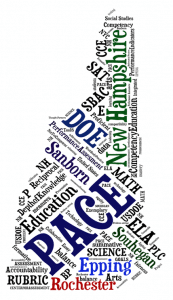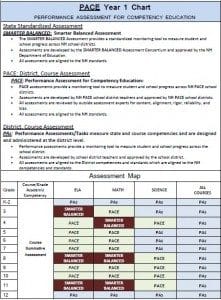Setting the PACE: Teacher Assessment Practices in a Competency-Based Education System
CompetencyWorks Blog

I continue to be amazed and impressed by our staff’s progress over the past five years related to our implementation of a competency-based education system. Our grading, assessment, and instructional practices have changed significantly during this time, as our teachers have continued to push forward in their quest to impact student learning.
Over the past two years, our focus has been on assessment. Our staff’s knowledge and growth related specifically to the assessment of students’ competency has grown significantly. Memorial School, an elementary school in Newton, NH, is part of the Sanborn Regional School District. Sanborn was one of four districts (Sanborn, Epping, Rochester, and Souhegan) to participate in a first-in-the-nation accountability strategy called PACE (Performance Assessment for Competency Education), which was recently approved by the US DOE. This joint venture between the NH DOE, the Center for Collaborative Education, the Center for Assessment, and the four participating school districts entails a reduced level of standardized testing (Smarter Balanced Assessment Consortium in NH) and involves the creation of locally developed, rigorous, comprehensive performance assessments by teams of teachers. These high quality performance assessments are designed to support deeper learning, and will be integrated within the units of study that students are currently engaged in, thereby creating no disruption to the learning process.
The benefits of this work are numerous. First and foremost, this effort is reflective of educators at literally every level within the State of New Hampshire working in unison to better educational experiences for our students—from teachers in the classroom to Commissioner Virginia Barry and Deputy Commissioner Paul Leather. Everyone involved truly felt that a single standardized assessment should not be the only factor determining a school’s and its students’ success. In the PACE model, the standardized assessment for reading and mathematics would be taken once at each level (elementary, middle, and high school), with complex, multi-part performance assessments administered to allow students to demonstrate and apply their knowledge in quite sophisticated ways. The performance assessments were created by teams of teachers, and were developed as part of the units of study that students would be engaged in during the mid-March to May timeframe, thereby allowing the assessments to be integrated within the daily activities that students and teachers were engaged in. Additionally, the assessments have been vetted by local, state, and national assessment experts and have provided teachers with the opportunity to look at their assessments through a critical lens of their own, something they are doing now on a consistent basis.
The concept of a performance assessment as an end-of-unit assessment was not necessarily “new” when we began our training through the Center for Collaborative Education and the NH DOE two years ago. Many of our staff had undergone professional development related to an Understanding by Design model and were utilizing this within their units of study. But what we were now learning required significantly more consideration of a number of factors as the assessments were being constructed. As our team of five educators went through the initial training, it became apparent to me as the building principal that we would need to take the process slowly, concentrating on each specific portion of the template to learn together how to build the best possible process for learning, as well as the best possible product to assess learning. We focused intensely on each stage of the process during the 2013-2014 school year (Looking at our Work Through an Assessment Lens), and each team of teachers successfully built a Quality Performance Assessment by the end of the year.
Our teachers, as they always do, have risen to the challenge yet again. A team-by-team report out during a recent team leaders’ meeting provided proof of our progress on building multiple performance assessments over the course of this past school year. Our school had set a goal to build, validate, administer, validate again through student work, refine, and submit three performance tasks within each grade level throughout the course of the year. Additionally, our specialists were responsible for going through this process with at least one task individually.
Clearly, this process is an extensive one. It would not be possible to accomplish any of this without highly functioning Professional Learning Communities, as this work demands a collaborative effort from everyone involved. The majority of all of our professional time this school year has been dedicated to this work, and our knowledge of student learning, competency, and assessment of competency has grown extensively.
Building multiple QPAs over the course of the year included the development of a common assessment that would be administered by specific grade levels at all schools within each of the PACE districts. Teachers from each school from these specific grade levels met to collaboratively build the PACE assessments, then validated them within their own teams or as a PACE team, depending upon the grade level. At the elementary level, our third grade students took the Smarter Balanced ELA assessment and were administered a PACE Math assessment. Our fourth grade students took the Smarter Balanced Math assessment and were administered an ELA PACE task. Our fifth graders were administered both an ELA and Math PACE assessment. The chart below, shared by our Director of Curriculum, Ellen Hume-Howard, outlines each grade level’s responsibilities (K-12) related to PACE, Smarter Balanced Assessment Consortium, and ongoing district assessments.

Rose Colby, Competency Education Specialist in NH, defines competency as “the ability to transfer content and skills in and across content areas.” During our team leader meeting, after each team member had reported out what they had accomplished, one of our teachers remarked that every summative assessment they were administering in their grade level was a performance assessment requiring students to demonstrate their competency through the transfer of their learning across content areas. This was a significant statement, because it is very clear to our teachers that the best performance assessments integrate multiple subject areas and are requiring students to be engaged in deeper levels of learning, precisely as Ms. Colby has described. Our teachers are now building cross-disciplinary assessments that require students to demonstrate varied competencies, whereas initially we were generally focusing on one subject area. Our specialists play an integral role in building these assessments, and our classroom teachers are tapping into their expertise in PE and the arts to create learning experiences for students that truly span, and require proficiency in, multiple content areas.
Each performance assessment that I see being constructed is of higher and higher quality. This is due not only to our teachers’ overall increased understanding of assessment in general, but also to their increased understanding of the nuances within each assessment. Considerations such as specific wording of a question, students’ background experiences, ability to provide appropriate accommodations, and the level of the depth of knowledge are intuitively included. Additionally, the formative assessments that occur leading up to an end-of-unit performance assessment are providing vital information for the teachers that they can (and do) immediately act upon to ensure each student’s success. As one teacher stated, “There should be no surprises when they take the summative. Everything leading up to that has been monitored closely. It’s their chance to show us everything they know and can do.”
Furthermore, teachers recognize the incredibly powerful data they are gleaning from these types of assessments. Their assessment practices as a whole reflect this understanding, as performance assessments have become the norm. Teachers are building a bank of assessments that they will continue to go back to year after year. But each year, each assessment is scrutinized and further developed based off of what the needs of the students are, what worked well when the assessment was given last, and most importantly, the student work samples from the last assessment (student work doesn’t lie!).
Our teachers continue to model our mission and guiding principal, “Learning for All.” They are refining their work on a continual basis, providing students with increasingly rich learning experiences, and creating assessments that are more consistently capturing our students’ ability to demonstrate their competency. And as their assessment literacy increases, instructional strategies and practices continue to develop. This has been a vital byproduct of our assessment focus. Students are provided more opportunities to demonstrate critical thinking at a higher depth of knowledge prior to the summative assessment. The formatives that are occurring along the way are providing vital information for teachers to provide the remediation and extension that each individual student needs.
Our teachers are willing to continuously examine all practices and adjust as appropriate, because we realize that there will always be room for improvement. The work of creating the optimal learning experiences for our students is never done, just a work in perpetual progress.
Jonathan is the Director of Innovative Projects for the New Hampshire Learning Initiative, overseeing the personalized and competency-based work related to NG2: Next Generation Collaborative Learning Design and the State of New Hampshire’s efforts integrating Work Study Practices into curriculum, instruction, and assessment.
Formerly, Jonathan was principal of Memorial Elementary School in Sanborn Regional School District in New Hampshire. Under his leadership, Memorial became a nationally recognized model professional learning community (PLC) on All Things PLC (allthingsplc.info) and competency-based learning elementary school.
Jonathan lives with his wife and three children on the New Hampshire Seacoast. You can follow Jonathan via Twitter @jvanderels